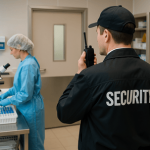
It’s 2025, and the logistics world is more connected—and more vulnerable—than ever before. From warehouse docks to fleet yards to final-mile delivery, every link in the supply chain is under pressure to move faster, operate smarter, and stay secure.
The question isn’t if your security systems need to evolve. It’s how fast you can adapt.
At SSP, we work alongside logistics operators, transit authorities, and warehouse leaders who face this challenge every day. Whether you're managing thousands of daily shipments or just trying to reduce cargo loss, staying ahead of emerging threats means embracing the technologies shaping the future of supply chain protection.
Here are the top security tech trends we’re watching in 2025—and what they mean for your operation.
l
l
1. AI-Powered Video Surveillance is Getting Smarter (and More Affordable)
AI is no longer reserved for massive transit hubs and enterprise logistics firms. In 2025, intelligent video analytics are becoming more accessible—and more powerful.
Key features driving adoption:
-
Real-time motion and object detection
-
Behavioral analytics to spot suspicious patterns
-
License plate recognition (LPR) at gate entries
-
Integration with access control and alarms
-
Facial recognition (in select, compliant applications)
Instead of watching feeds all day, security teams are responding to smart alerts, reducing missed incidents and response times.
Why it matters: AI helps detect risks proactively—before cargo is stolen, doors are forced, or unauthorized access happens.
k
k
2. Cloud-Based Access Control is Replacing On-Prem Systems
Traditional access control systems with on-site servers and outdated software are phasing out. In their place? Cloud-native platforms that offer real-time management, mobile credentialing, and centralized oversight across all facilities.
Cloud access control allows you to:
-
Instantly revoke access across multiple sites
-
Use smartphones as secure credentials
-
Set schedules, zones, and user roles remotely
-
View audit logs and access events from any device
At SSP, we’re seeing increased demand for these systems from logistics facility security managers who want more control without more complexity.
k
k
3. Mobile Credentials Are Becoming the New Standard
Keycards and fobs are still around—but more logistics teams are switching to mobile access solutions.
Why?
-
Phones are harder to lose or lend out
-
They support multi-factor authentication
-
Credentials can be issued and revoked instantly
-
They work well with contractors, vendors, and rotating shift workers
SSP helps clients transition to mobile credentials while integrating them into their existing security infrastructure, ensuring flexibility and scalability.
k
k
4. 24/7 Remote Monitoring and Co-Managed Security Are on the Rise
With security staff stretched thin—and incidents often occurring after hours—many logistics operators are turning to co-managed security models.
This means pairing your on-site team with SSP’s 24/7/365 support and remote monitoring, ensuring nothing gets missed. Our technicians assist with:
-
Real-time alert verification
-
System health monitoring
-
Incident escalation
-
Remote access troubleshooting
It’s like extending your security team without hiring full-time staff.
k
k
5. Cyber + Physical Integration Is Now a Must
In today’s supply chain, cyber threats and physical breaches are tightly connected. A bad actor doesn’t need to cut a fence if they can hack into your camera system or access logs.
That’s why 2025 is seeing more logistics and transit security teams collaborate with IT and cybersecurity departments. Together, they’re working to secure:
-
Network-connected access control systems
-
IP-based surveillance cameras
-
Cloud storage and user credentials
-
Remote login portals for monitoring tools
SSP takes a converged security approach, helping clients evaluate both physical and digital risks when designing or upgrading systems.
k
k
6. Environmental Monitoring Is Now Part of Supply Chain Security
Security isn’t just about people—it’s also about protecting cargo from environmental threats.
In 2025, more facilities are adding sensors to detect:
-
Fire or smoke in staging areas
-
Water leaks near storage zones
-
Temperature fluctuations in cold storage
-
Unauthorized door openings or loading activity
These sensors integrate with video and access systems to trigger alerts or lockdowns. It’s another layer of supply chain protection that helps maintain quality, safety, and compliance.
k
k
7. AI Incident Reporting & Automation Tools Are Gaining Adoption
Security teams don’t have time to write detailed reports or sift through hours of footage. That’s why SSP is helping clients deploy automated incident logging, including:
-
Event tagging based on AI alerts
-
Auto-generated video clips
-
Time-stamped access logs
-
Pre-filled incident templates for faster reporting
This automation helps logistics operators respond faster, investigate smarter, and document everything accurately—especially when dealing with insurance or compliance requirements.
k
k
Final Thoughts: Don’t Just Keep Up—Get Ahead
The threats facing today’s supply chains are evolving. Fortunately, so are the tools available to protect them.
At SSP, we don’t just sell cameras or access control—we design integrated, future-ready security systems that grow with your operation. Whether you're protecting a single depot or an entire multi-state logistics network, we’ll help you navigate what’s next.
Discover how SSP keeps transportation systems secure and operational.
Contact us today for a security consultation tailored to your supply chain.


